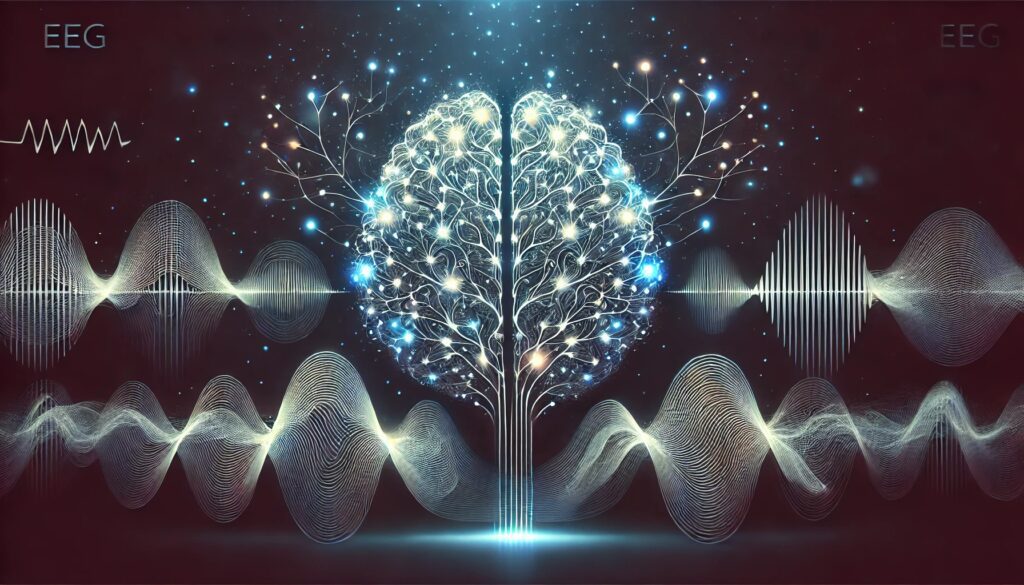
Machine learning (ML) for identifying brain-specific biomarkers from EEG data is at the forefront of advances in neuroscience and computational biology. As the brain’s electrical activity is complex and constantly changing, EEG provides a unique, non-invasive method to monitor these dynamics in real-time. Coupled with machine learning, EEG analysis is evolving to identify biomarkers—distinctive patterns that correlate with specific brain conditions, states, or traits. Let’s explore the intricacies of this fascinating intersection of technology and neuroscience.
Understanding EEG: The Gateway to the Brain
Electroencephalography (EEG) captures electrical activity in the brain by recording voltage fluctuations resulting from ionic current flows within neurons. It’s highly valued for its non-invasive nature, high temporal resolution, and ability to monitor brain activity continuously. However, interpreting EEG data is not straightforward due to its inherent complexity, which is why machine learning techniques are invaluable in extracting meaningful patterns.
Feature Extraction: The Heart of EEG Analysis
The first crucial step in EEG analysis is feature extraction, which involves isolating and emphasizing the most informative aspects of the EEG signals. This step is critical because raw EEG data is vast and contains many irrelevant or redundant information.
Time-Domain Features
Time-domain analysis focuses on the amplitude of the EEG signal over time. Common features include:
- Mean and Variance: Basic statistical measures that provide insight into the average brain activity and its variability.
- Entropy: A measure of the randomness or complexity within the EEG signal. Higher entropy might indicate a more chaotic brain state.
- Skewness and Kurtosis: These measures help in understanding the distribution of the signal’s amplitude, identifying any asymmetry or the presence of extreme values (peaks).
Frequency-Domain Features
Since the brain’s electrical activity is often best understood in terms of its frequency components, frequency-domain features are crucial. Techniques such as:
- Power Spectral Density (PSD): This measure reveals the power distribution across different frequency bands (delta, theta, alpha, beta, and gamma). Each band is associated with different cognitive and physiological states. For example, increased alpha power might be linked to relaxation, while gamma rhythms are associated with higher cognitive functions.
- Band Power: Specific to certain frequency ranges, this can indicate the dominance of certain brain states, like the increased beta activity often seen in anxious or active minds.
Time-Frequency Representations
EEG signals are non-stationary, meaning their statistical properties change over time. To capture these dynamics, time-frequency representations are used:
- Wavelet Transform: Unlike Fourier transforms, wavelet transforms can analyze signals at multiple scales, making them ideal for identifying transient features like spikes or oscillations that occur in specific time windows.
- Short-Time Fourier Transform (STFT): This method applies Fourier analysis over short, overlapping time windows, providing a balance between time and frequency resolution. It’s particularly useful for analyzing rhythmic activities that change over time.
Spatial Features
The brain is a highly interconnected organ, and spatial features aim to capture these connections:
- Source Localization: Techniques such as beamforming or minimum norm estimates help identify the origins of electrical activity within the brain, providing spatial context to the EEG signals.
- Functional Connectivity: This involves analyzing the synchrony or phase relationships between different brain regions, which can reveal networks of activity that underpin various cognitive functions or states.
Machine Learning Techniques: Extracting Knowledge from Data
Once features are extracted, machine learning algorithms are employed to interpret them. Different approaches are suited to different types of analyses:
Supervised Learning
In supervised learning, the goal is to train models on labeled data, where the correct output (e.g., a specific brain condition) is known:
- Support Vector Machines (SVM): These are powerful classifiers that find the hyperplane which best separates different classes of EEG data. SVMs are particularly useful when the data is high-dimensional and the classes are not linearly separable.
- Random Forests: A type of ensemble learning method that constructs multiple decision trees during training and outputs the mode of the classes (classification) or mean prediction (regression) of the individual trees. This method is robust to overfitting and works well with complex EEG data.
- Convolutional Neural Networks (CNNs): Although traditionally used in image processing, CNNs have been adapted for EEG data, particularly for recognizing spatial patterns in multichannel EEG recordings. Their ability to automatically detect important features makes them suitable for complex classification tasks, such as distinguishing between different stages of sleep or identifying epileptic seizures.
Unsupervised Learning
Unsupervised learning is used when there are no labeled outcomes. The goal here is to uncover hidden structures or patterns within the data:
- K-Means Clustering: This algorithm partitions the EEG data into k clusters, where each data point belongs to the cluster with the nearest mean. It’s useful for identifying natural groupings in the data, such as distinguishing between different cognitive states without prior labeling.
- Principal Component Analysis (PCA): PCA reduces the dimensionality of EEG data by projecting it onto a set of orthogonal components that capture the maximum variance. This simplifies the data while retaining its most important features, making it easier to identify potential biomarkers.
Deep Learning
Deep learning, especially using recurrent architectures, is increasingly prominent in EEG analysis:
- Recurrent Neural Networks (RNNs): RNNs are suited to sequence data like EEG because they have connections that form directed cycles, allowing them to maintain a ‘memory’ of previous inputs. This is crucial for capturing temporal dependencies in EEG signals, such as recognizing patterns that unfold over time.
- Long Short-Term Memory (LSTM) Networks: LSTMs are a type of RNN designed to overcome the vanishing gradient problem, making them capable of learning long-term dependencies. They are particularly effective for tasks like predicting future brain states or identifying sequences of EEG patterns associated with specific cognitive or emotional processes.
Applications: From Diagnosis to Brain-Computer Interfaces
The potential applications of machine learning in EEG analysis are vast, spanning several domains:
Neurological Disorders
ML models can help detect biomarkers for various neurological disorders:
- Epilepsy: By identifying abnormal spikes or patterns in EEG, ML models can help in predicting seizures or diagnosing epilepsy with higher accuracy.
- Alzheimer’s Disease: Early detection is crucial for managing Alzheimer’s. ML-driven analysis of EEG can identify subtle changes in brain activity associated with the disease, potentially even before clinical symptoms appear.
- Schizophrenia and Depression: ML models can detect the neural signatures of psychiatric conditions, aiding in diagnosis and treatment personalization.
Cognitive and Affective States
ML can track changes in cognitive and affective states:
- Cognitive Load: In educational settings, understanding a student’s cognitive load through EEG could lead to more effective teaching strategies.
- Emotional States: Recognizing emotional states via EEG can be used in areas like marketing or mental health, providing real-time feedback and intervention opportunities.
- Fatigue Detection: This is especially useful in safety-critical jobs (e.g., aviation, surgery), where monitoring an individual’s fatigue levels could prevent accidents.
Brain-Computer Interfaces (BCI)
BCIs translate brain signals into commands that control external devices, opening up new possibilities for individuals with disabilities:
- Rehabilitation: ML models can identify EEG biomarkers that facilitate motor rehabilitation, helping patients regain control over their limbs through neurofeedback.
- Assistive Technologies: For individuals with severe motor impairments, BCIs powered by ML can enable communication or control of prosthetic devices, improving their quality of life.
Personalized Medicine
The ultimate goal of ML in EEG analysis is to enable personalized medicine:
- Tailored Treatment Plans: By identifying individual-specific brain patterns, treatments can be customized to the patient’s unique neurophysiological profile, improving outcomes in conditions like depression or epilepsy.
Challenges and Solutions: Navigating the Complexities
While the potential is immense, several challenges remain:
Data Quality and Preprocessing
EEG data is highly prone to noise and artifacts:
- Filtering: High-pass, low-pass, and band-pass filters are used to remove unwanted frequencies.
- Artifact Removal: Techniques like Independent Component Analysis (ICA) are employed to isolate and remove artifacts (e.g., eye blinks, muscle movements) from EEG signals without losing valuable brain activity information.
Interpretability
Deep learning models, particularly those used in EEG analysis, are often criticized for being “black boxes”:
- Model Interpretation Tools: Techniques like Grad-CAM (Gradient-weighted Class Activation Mapping) or SHAP (SHapley Additive exPlanations) help in understanding what features the model is focusing on when making predictions.
- Clinician Collaboration: Close collaboration between data scientists and clinicians ensures that the identified biomarkers are not only statistically significant but also clinically relevant.
Generalization
To ensure that biomarkers identified in one population apply to others:
- Cross-Validation: Robust cross-validation techniques help in testing the model on different subsets of data to ensure it generalizes well.
- Large, Diverse Datasets: Gathering and using large, diverse datasets is crucial for creating models that are broadly applicable across different demographics.
Computational Complexity
Analyzing high-dimensional EEG data is resource-intensive:
- Efficient Algorithms: Implementing more efficient algorithms and leveraging hardware accelerations, such as GPUs, can significantly reduce computational time.
- Parallel Processing: Utilizing parallel processing techniques can speed up the analysis of large datasets.
Ethical Considerations: Balancing Innovation with Responsibility
As with any powerful technology, the use of ML in EEG data analysis raises
important ethical issues:
Privacy
EEG data is sensitive and personal:
- Data Encryption: Strong encryption methods are essential to protect EEG data from unauthorized access.
- Anonymization: Removing personally identifiable information from EEG datasets helps protect patient privacy.
Bias
ML models can inherit biases from the data they are trained on:
- Diverse Training Data: Ensuring that training data includes a wide range of demographics and conditions can help minimize bias.
- Fairness Metrics: Implementing fairness metrics in the model evaluation process ensures that the model performs equitably across different groups.
Clinical Integration
Translating ML research into clinical practice is challenging:
- Interdisciplinary Collaboration: Successful integration requires close collaboration between clinicians, researchers, and data scientists to ensure that ML models are not only accurate but also practical and beneficial in a clinical setting.
- Regulatory Approval: Ensuring that ML-driven diagnostics meet regulatory standards is crucial for their adoption in healthcare.
Future Directions: The Next Frontier in EEG and Machine Learning
Looking ahead, the future of ML in EEG biomarker discovery is incredibly promising:
Multimodal Biomarker Discovery
Combining EEG with other neuroimaging modalities:
- fMRI and MEG: Integrating EEG with functional MRI (fMRI) or Magnetoencephalography (MEG) could lead to the discovery of more comprehensive biomarkers that capture both the temporal and spatial dynamics of brain activity.
Transfer Learning and Federated Learning
Enhancing the scalability and applicability of ML models:
- Transfer Learning: This approach involves training a model on one task and applying it to another related task, reducing the need for large labeled datasets in every new application.
- Federated Learning: This method enables the training of models on data from multiple institutions without sharing the actual data, enhancing privacy while improving model robustness.
Real-Time Analysis and Closed-Loop Systems
The ultimate goal is to develop systems that not only detect but also respond to brain states in real-time:
- Neurofeedback: Real-time analysis can be used in neurofeedback systems, where the ML model provides immediate feedback based on the detected brain state, helping individuals self-regulate their brain activity.
- Adaptive BCI Systems: Closed-loop BCIs could adjust their functioning based on real-time EEG analysis, optimizing the interaction between the brain and external devices.
Conclusion: A New Era in Neuroscience
Machine learning is set to revolutionize the identification and application of brain-specific biomarkers from EEG data. The combination of advanced feature extraction techniques, sophisticated ML algorithms, and interdisciplinary collaboration is opening new doors in neurology, psychology, and personalized medicine. As these technologies continue to evolve, they hold the potential to unlock new insights into brain function, enhance diagnostic accuracy, and ultimately improve the quality of life for individuals with neurological and psychiatric conditions.
FAQs on Machine Learning for EEG Biomarker Discovery
What is an EEG and how is it used in neuroscience?
Electroencephalography (EEG) is a non-invasive method that records electrical activity in the brain using electrodes placed on the scalp. It is commonly used in neuroscience to study brain functions, diagnose neurological disorders, and monitor brain activity in real-time. EEG is particularly valued for its high temporal resolution, allowing researchers to track rapid changes in brain activity.
What are brain-specific biomarkers?
Biomarkers are measurable indicators of biological states or conditions. In the context of EEG, brain-specific biomarkers refer to patterns in the EEG data that are associated with specific brain states, conditions, or traits. These could include markers for diseases like epilepsy or Alzheimer’s, or indicators of cognitive states such as attention, stress, or fatigue.
How does machine learning contribute to the analysis of EEG data?
Machine learning enhances EEG data analysis by automating the identification of complex patterns that may not be easily detectable through traditional methods. ML algorithms can be trained to recognize specific EEG patterns associated with different brain conditions, helping to identify biomarkers that can be used for diagnosis, monitoring, or even predicting neurological events like seizures.
What types of machine learning algorithms are commonly used in EEG analysis?
Several types of machine learning algorithms are used, including:
- Supervised Learning: Techniques like Support Vector Machines (SVM), Random Forests, and Convolutional Neural Networks (CNNs) are used for classification tasks, such as distinguishing between different cognitive states or detecting neurological disorders.
- Unsupervised Learning: Methods like K-means clustering and Principal Component Analysis (PCA) help identify hidden patterns in EEG data without pre-labeled outcomes.
- Deep Learning: Recurrent Neural Networks (RNNs) and Long Short-Term Memory (LSTM) networks are used to model the temporal dependencies in EEG signals, making them suitable for analyzing complex sequences of brain activity.
What are the main challenges in using machine learning for EEG analysis?
Some of the key challenges include:
- Data Quality: EEG data is often noisy and can contain artifacts from non-brain sources, making preprocessing crucial.
- Interpretability: Many machine learning models, especially deep learning, function as “black boxes,” making it difficult to understand how they arrive at specific decisions.
- Generalization: Ensuring that biomarkers identified in one population are applicable to others is a significant challenge.
- Computational Complexity: Analyzing high-dimensional EEG data can be computationally intensive, requiring advanced algorithms and hardware.
How can machine learning help in diagnosing neurological disorders?
Machine learning models can be trained to recognize specific EEG patterns associated with neurological disorders like epilepsy, Alzheimer’s, or schizophrenia. By analyzing these patterns, ML can help in early diagnosis, monitoring disease progression, and even predicting events like seizures, leading to more timely and targeted interventions.
What is the role of feature extraction in EEG analysis?
Feature extraction is the process of identifying and isolating the most informative aspects of EEG signals, such as time-domain features (e.g., mean, variance), frequency-domain features (e.g., power spectral density), and spatial features (e.g., connectivity patterns). This step is essential because it simplifies the data, making it more manageable for machine learning algorithms to analyze.
What ethical considerations are involved in applying machine learning to EEG data?
Ethical considerations include:
- Privacy: EEG data is highly sensitive, and protecting patient privacy is crucial.
- Bias: Ensuring that ML models are trained on diverse datasets to avoid biases that could affect the identification of biomarkers.
- Clinical Integration: Translating ML-identified biomarkers into clinical practice requires careful validation and collaboration between data scientists and clinicians to ensure accuracy and relevance.
What are the future directions in EEG and machine learning research?
Future research is likely to focus on:
- Multimodal Biomarker Discovery: Combining EEG with other neuroimaging techniques like fMRI or MEG to create more comprehensive models.
- Transfer Learning and Federated Learning: These approaches will enhance the scalability and adaptability of ML models across different populations and settings.
- Real-Time Analysis and Closed-Loop Systems: Developing systems that not only detect but also respond to brain states in real-time, such as in neurofeedback or adaptive BCIs.
How can I start learning about machine learning applications in EEG analysis?
You can start by exploring the resources mentioned earlier, including:
- Books on neural engineering and brain-computer interfaces.
- Research Papers from journals like the Journal of Neural Engineering and NeuroImage.
- Online Courses on platforms like Coursera and edX that cover neuroscience and machine learning.
- Kaggle for hands-on practice with EEG datasets and tutorials on applying machine learning to biomedical data.
Resources
Here are some valuable resources that provide more in-depth information on machine learning for EEG biomarker discovery:
- Books:
- “Brain-Computer Interfaces: Principles and Practice” by Jonathan Wolpaw and Elizabeth Winter Wolpaw: This book provides a comprehensive introduction to the principles of BCIs, including EEG signal processing and machine learning techniques.
- “Neural Engineering: Computation, Representation, and Dynamics in Neurobiological Systems” by Chris Eliasmith and Charles H. Anderson: A great resource for understanding the computational approaches in neuroscience, including machine learning applications.
- “Deep Learning for EEG-Based Brain-Computer Interfaces: Representations, Algorithms and Applications” by Xiang Zhang: This book focuses on the use of deep learning in analyzing EEG data, with detailed explanations of algorithms and their applications.
- Research Papers:
- “Deep learning with convolutional neural networks for EEG decoding and visualization” by Cecotti, H. & Gräser, A. (2018): This paper discusses the application of CNNs for EEG signal classification and the potential of deep learning in brain-computer interface systems.
- “EEG-based brain-computer interfaces: A thorough literature survey” by Nicolas Lotte et al. (2018): A comprehensive review of EEG-based BCIs, including the use of machine learning methods for feature extraction and classification.
- “A review of EEG-based brain-computer interfaces as access pathways for individuals with severe disabilities” by Fazel-Rezai, R. et al. (2012): A focused review on the use of EEG and ML for assistive technologies.
- Online Courses and Tutorials:
- Coursera – “Neuroscience and Neuroimaging”: This course covers the basics of neuroimaging, including EEG, and discusses how machine learning can be applied to analyze brain data.
- edX – “Fundamentals of Neuroscience”: This series of courses from Harvard University provides a foundation in neuroscience, including the principles of EEG.
- Kaggle – “EEG Machine Learning and Signal Processing”: Kaggle offers a variety of datasets and tutorials on applying machine learning to EEG data.
- Websites and Online Communities:
- IEEE Xplore: Access to numerous research papers on EEG, machine learning, and biomarker discovery.
- GitHub: Search for repositories on EEG analysis and machine learning; many researchers share their code, which can be an excellent resource for learning and experimentation.
- Reddit – r/neuroscience and r/MachineLearning: These communities often discuss the latest research, tools, and techniques related to EEG and ML.
- Journals:
- Journal of Neural Engineering: This journal publishes research at the intersection of neuroscience, engineering, and machine learning, often focusing on EEG.
- NeuroImage: NeuroImage – ScienceDirect
- IEEE Transactions on Biomedical Engineering: IEEE Transactions on Biomedical Engineering – IEEE Xplore
These resources should provide a solid foundation for further exploration into the use of machine learning in EEG analysis for biomarker discovery.





